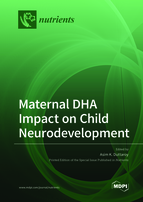Maternal DHA Impact on Child Neurodevelopment
A special issue of Nutrients (ISSN 2072-6643). This special issue belongs to the section "Lipids".
Deadline for manuscript submissions: closed (31 December 2020) | Viewed by 30049
Special Issue Editor
Interests: lipids and brain development; fatty acid uptake system in human placenta; angiogenesis; feto-placental growth and development; DHA and cell growth and proliferation; lipid nutrition; eicosanoids; cardiovascular health; platelet function
Special Issues, Collections and Topics in MDPI journals
Special Issue Information
Dear colleagues,
The developmental environment of the fetus is dependent on two major factors: maternal nutritional state and placental function. Maternal long-chain polyunsaturated fatty acids (LCPUFAs) and their metabolites are involved in every stage of pregnancy by supporting cell growth and development, cell signaling, and modulating other critical aspects of structural and functional processes. Long-chain fatty acids stimulate early placentation by enhancing angiogenesis in placental trophoblasts via various growth factors, LCPUFA metabolites, and fatty-acid-binding proteins. Inadequate placental angiogenesis and trophoblast invasion of the maternal decidua and uterine spiral arterioles leads to structural and functional deficiency of the placenta, which contributes to overall fetal growth and the development of important organs such as the brain. During the third trimester of pregnancy, placental preferential transport of maternal plasma LCUPFAs such as docosahexaenoic acid (22:6 n-3; DHA), and arachidonic acid (20:4n-6) is of critical importance for fetal growth and development. DHA is essential for normal healthy brain development, maintenance, and function. Many studies have shown that DHA metabolism and signaling systems are involved in neurogenesis, anti‐nociceptive effects, anti‐apoptotic effects, synaptic plasticity, Ca2+ homeostasis, and in the functioning of nigrostriatal pathways. Several metabolites of DHA are also involved in several processes, but full mechanisms are not yet known. Long-chain fatty acids mainly cross the placental microvillous and basal membranes via the plasma membrane fatty acid transport system. Maternal diet, metabolic disease, obesity, and diabetes can affect the expression of placental nutrient transporter activities. Studies strongly suggest that maternal dietary deficiency of DHA during pregnancy increases the risk for neurocognitive disorders. Fetal DHA inadequacy and its impact on child neurodevelopment has been observed. Several randomized trials of maternal DHA supplementation in pregnancy have been carried out. Maternal dietary deficiency of n‐3 fatty acids during development in utero and in the postnatal state has detrimental effects on cognitive abilities. Fetal DHA inadequacy and its impact on child neurodevelopment have been observed.
The objective of this Special Issue on “Placental Transport of Maternal DHA to the Fetus and the Impact on Child Neurodevelopment ” is to showcase the latest research focusing on the impact of maternal diet, metabolic diseases, diabetes, and the status on placental fatty acid and transport in fetal brain development and knock-on effects on child cognition as well as intervention studies with LCPUFAs during pregnancies with consideration of fetal outcome.
This Special Issue is intended to provide a contemporary summary of current knowledge while providing guidance for future research in the field.
Prof. Asim K. Duttaroy
Guest Editor
Manuscript Submission Information
Manuscripts should be submitted online at www.mdpi.com by registering and logging in to this website. Once you are registered, click here to go to the submission form. Manuscripts can be submitted until the deadline. All submissions that pass pre-check are peer-reviewed. Accepted papers will be published continuously in the journal (as soon as accepted) and will be listed together on the special issue website. Research articles, review articles as well as short communications are invited. For planned papers, a title and short abstract (about 100 words) can be sent to the Editorial Office for announcement on this website.
Submitted manuscripts should not have been published previously, nor be under consideration for publication elsewhere (except conference proceedings papers). All manuscripts are thoroughly refereed through a single-blind peer-review process. A guide for authors and other relevant information for submission of manuscripts is available on the Instructions for Authors page. Nutrients is an international peer-reviewed open access semimonthly journal published by MDPI.
Please visit the Instructions for Authors page before submitting a manuscript. The Article Processing Charge (APC) for publication in this open access journal is 2900 CHF (Swiss Francs). Submitted papers should be well formatted and use good English. Authors may use MDPI's English editing service prior to publication or during author revisions.
Keywords
- DHA
- human placenta
- fetus
- brain development
- maternal diet
- diabetes
- metabolic disease
- fatty acid transport
- neurodevelopment
- feto-placental growth
- placentation







